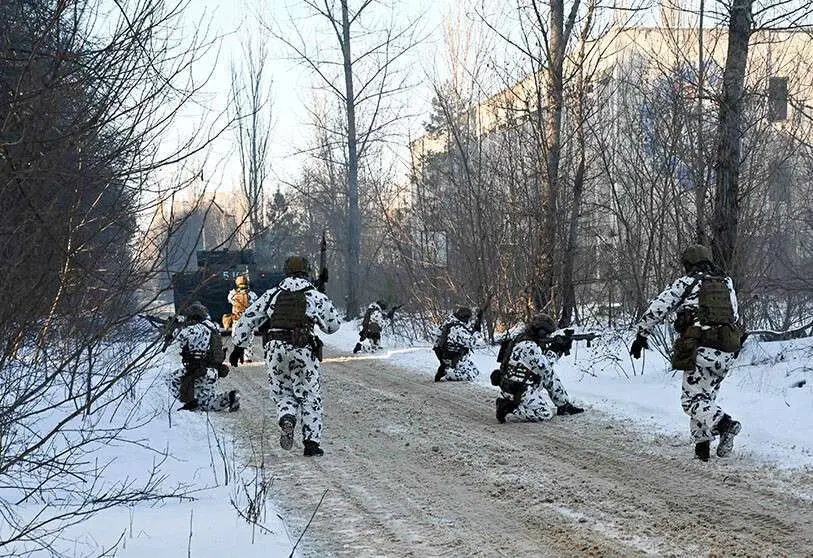Chernobyl, the fastest route for entry into Kiev

As part of Russia's blitzkrieg operation on Ukrainian territory, Kremlin troops took control of the Chernobyl nuclear power plant in northern Ukraine on Thursday. "Russian occupation forces are trying to take control of the Chernobyl plant. Our defenders are sacrificing their lives to prevent a repetition of the 1986 tragedy," Ukrainian President Volodymyr Zelensky posted on his official Twitter account just hours before the Kiev government announced in an official statement that the Russian contingent had taken control of the plant.
Interior Ministry adviser Anton Gerashchenki also added his voice to the warning, reporting that clashes were taking place near the Chernobyl plant's nuclear waste repository. "The occupying forces entered the area of the Chernobyl plant from Belarus, but the Ukrainian National Guard members protecting the depot are demonstrating fierce resistance," Gerashchenki said on his Telegram channel.
However, it was not long before Denys Shmyhal, the Ukrainian prime minister, regretted to report that "the Chernobyl zone, the so-called Chernobyl exclusion zone and all structures of the Chernobyl nuclear power plant are under the control of Russian armed groups", he announced during a press conference.

One of the doubts that the Russian army's eagerness has seemed to provoke is Moscow's interest in controlling a crippled nuclear power plant surrounded by miles and miles of radioactive terrain. According to several experts, the relevance of Russia's control of Chernobyl is no more than purely geographical.
This was stated by former US Army Chief of Staff Jack Kane, who explained that the plant has "no military significance", but is located on the shortest route between Belarus and Kiev. In the same vein, James Acton of the Carnegie Endowment for International Peace explained to Al-Ain News that this route represents "the quickest way to get from point A to point B". The nuclear power plant is located just 15 kilometres from the southern border of Belarus, and less than 100 km from the capital, Kiev.

Assuming that Chernobyl had become a strategic enclave for a possible Russian invasion, the Ukrainian State Agency for the Management of the Exclusion Zone announced last Saturday the forced evacuation of the territory for all Ukrainian citizens who were not fulfilling their work obligations in the area.
"It doesn't matter if it's contaminated or if nobody lives here," Yuri Shakhraichuk, a lieutenant colonel in the Ukrainian border guards, told the New York Times a few weeks ago. "It is our territory, our country, and we must defend it."

Now, with the arrival of the strong movements caused by heavy military machinery, experts warn that the topsoil could lift and spread into the air, increasing radiation levels in the territory and the rest of the country. "There was an increase in indicators above control levels at 03h20 hours," the deputy head of the Ukrainian Department for the Safety of Nuclear Facilities, Alexander Grigorach, told the AFP news agency.
For its part, Moscow has claimed that the situation was under control. "Radiation in the area of the nuclear power plant is in line with the norm," Russian Defence Ministry spokesman Igor Konashenkov said. "An agreement has been reached with a battalion of the Ukrainian atomic energy security forces to jointly secure the energy blocks and the sarcophagus of the nuclear power plant."
Faced with this scenario, the director general of the International Atomic Energy Agency, Rafael Mariano Grossi, called for "maximum restraint to avoid any action that could put the country's nuclear facilities at risk". Grossi stressed to the international community that it is of "vital importance that the safe and secure operations of the nuclear facilities in this area are not affected".

For more than three decades, the word "Chernobyl" has inevitably evoked images of tragedy and devastation for the Ukrainian people. In April 1986, the plant's reactor number 4 suffered a core meltdown and, with the containment chamber unprotected, the resulting steam broke through the roof and rained pieces of fuel rods and highly radioactive graphite into the region.
Despite the nuclear disaster, the inability to generate enough electricity to replace the plant meant that Chernobyl did not shut down the last of its reactors until 2000.
Now, following the installation of the 'New Safe Sarcophagus' (NSC) in 2017 - an arch-shaped structure that will prevent the leakage of radiation from the reactor to the outside for the next 100 years, and which was funded by the International Chernobyl Shelter Fund - Kiev aims to re-secure the territory, and keep it as radiation-free as possible for decades to come. However, the violent advance of Russian troops through the Exclusion Zone could jeopardise the Ukrainian government's objectives.










